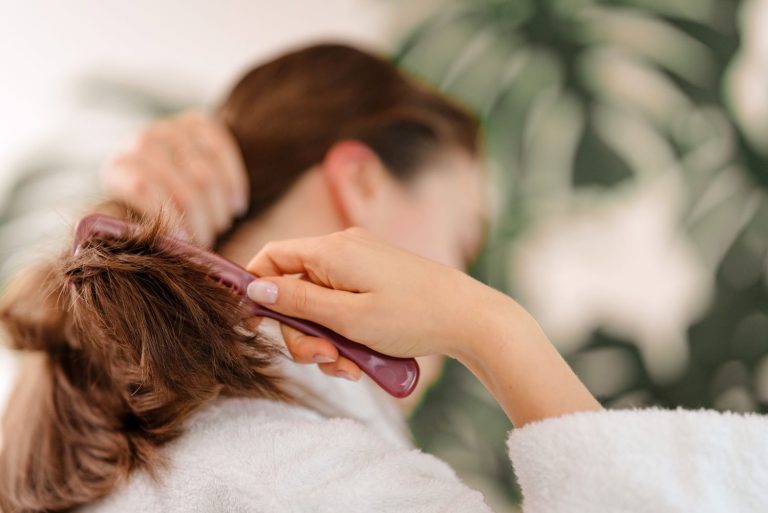Humectants are substances that attract and retain water molecules, keeping things moist and hydrated by drawing moisture from the air or from deeper layers of the skin.
They are often added to skin care and hair care products, such as shampoos and conditioners, body lotions, and lip balm. Types of humectants include hyaluronic acid, glycerin, urea, and aloe vera.
Jump to Key Takeaways.
How Do Humectants Work?
Humectants work by drawing moisture to an area that needs more hydration. They can do this in two ways:
- They can increase water absorption into the outer layers of the skin by pulling water from deeper layers of the skin.
- They can also draw water from the environment around you, such as the air.
Types of Products Containing Humectants
Humectants are added to products to promote hydration. Those products can include:
- Food as a preserving agent to keep them from drying out
- Skin care products, including face washes, serums, moisturizers, lotions, and masks
- Hair care products, including shampoos, conditioners, and masks
- Lip care products, including lip balms
- Nail care products
- Cosmetic products
- Some pharmaceuticals
- Electronic cigarettes
Examples
There are many types of humectants. They include:
- Urea: Urea is a compound produced by the liver. It is considered a waste product and is typically excreted from the body through urine.
- Sorbitol: Sorbitol is a form of sugar alcohol that acts as a carbohydrate in the body. It is naturally occurring in some fruits and vegetables but is also synthetically made.
- Panthenol: Panthenol is a natural component found in B complex vitamins. It is often referred to as a provitamin.
- Glycerol/glycerin: Glycerol is a type of sweet-tasting, colorless, and odorless liquid. It is found in specific lipids, specifically glycerides.
- Propylene glycol: Propylene glycol is another colorless liquid with a sweet taste. It’s an artificial alcohol.
- Hyaluronic acid: Hyaluronic acid naturally occurs within the body and maintains the skin’s structure and elasticity. It can also lubricate joints, hydrate the skin, and help with wound healing.
- Alpha hydroxy acids, including glycolic acid, lactic acid, sodium pyrrolidine, and carboxylic acid: These acids are organic and can break down dead skin cells. They can be found in milk, sugar cane, and some fruits.
- Butylene glycol: This colorless liquid is a form of alcohol derived from various sources, including sugar cane, distilled corn, or petroleum.
Natural Examples of Humectants
There are also several food-based humectants, including:
- Honey
- Aloe vera
- Konjac
- Egg albumin
- Isolated soy protein
- Sucrose
- Carrageenan
- Duck skin
- Fruits, including kiwi, pineapple, and tomatoes
Humectant Benefits
There are several benefits associated with the use of humectants, including:
- Retaining moisture in the skin and hair
- Improving the skin barrier function, which is the barrier that helps protect the skin against water loss and damage
- Anti-aging properties by maintaining the flexibility and elasticity of the skin
- Retaining moisture and preserving foods
- Speeding up wound repair
- Helping to manage skin conditions, such as eczema
Are They Safe?
Humectants are generally regarded as safe, and many of them occur naturally in the body.
Typically, the only issue people may experience when using humectants is an intolerance, sensitivity, or allergy, depending on the type.
For example, synthetic alcohols, such as propylene glycol, act as humectants but can lead to contact dermatitis.
Knowing a Product Is Safe for You
If you’ve never used a cosmetic or skin care product that has specific ingredients, it’s essential to do a patch test with a dermatologist to ensure that any humectant ingredients do not cause irritation. If they do, you can discontinue use.
How to Use for Skin Care
Choosing the right humectant ingredient is a personal choice that depends heavily on the formulation, your skin type, and the consistency of the product you are using.
For example, if you have oily or acne-prone skin, you should avoid products that contain oils or other ingredients that could cause an issue. Types of humectants that may benefit acne-prone skin include alpha-hydroxy acids.
For dry skin or if you have a skin condition that presents with dry skin, glycerin and urea are excellent options. It’s about finding the right humectant to suit your skin.
To ensure the products do their job correctly, you will have to:
- Clean the skin using lukewarm water
- Ensure it is dry
- Apply it in a thin layer until the skin absorbs it
- Avoid using alkaline soap, which could cause more damage to the skin barrier
How to Use for Hair Care
Humectants are commonly found in many hair care products, particularly those designed to address hair loss and thinning hair.
Other types of hair products that contain humectants are those that promise to deliver hydration and moisture to the hair. They include:
- Shampoos
- Conditioners
- Leave-in conditioners
- Hair masks
To use these products, follow the instructions on the labels carefully. If you are unsure whether you have an allergy or sensitivity to humectants before using hair care products that contain them, you can perform a patch test.
Key Takeaways
- Humectants are added to various products to maintain moisture, including food, skin care, and pharmaceutical products.
- Humectants for hair and skin function by drawing moisture into the affected area, either from the surrounding air or from within the body.
- Using humectants is generally considered safe. That said, individuals with allergies or sensitivities to humectants should avoid products that contain them.


